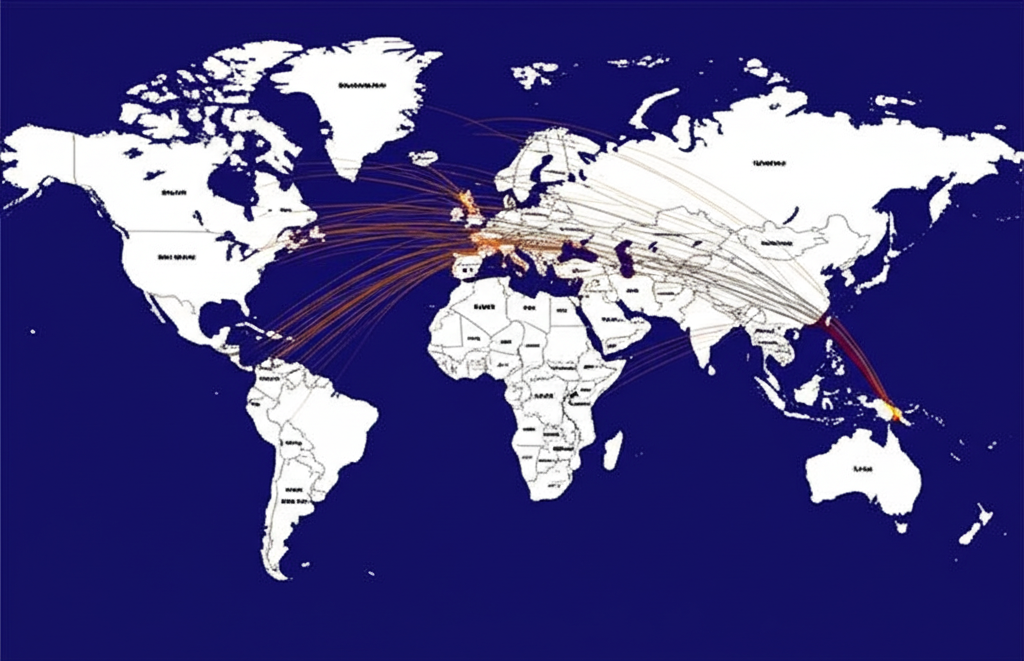Introduction to India ETFs for United States Investors in 2025
American investors looking to expand beyond familiar markets have a strong case for exploring India exchange-traded funds in 2025. These funds pool together a range of Indian stocks or related assets and trade on major U.S. exchanges, much like any standard stock. They deliver an easy, spread-out entry point into one of the globe’s quickest-expanding major economies. With India’s economy charging ahead-thanks to its expanding middle class, key policy changes, and advanced digital systems-India ETFs stand out as a smart move for spreading out investments and tapping into emerging market gains. This guide breaks down everything U.S. investors need to know about these funds, including their upsides, downsides, and how to get started next year.

India’s appeal lies in its blend of rapid development and structural strengths that set it apart from other regions. For U.S. portfolios heavy on domestic holdings, adding India exposure can balance things out, especially as the country navigates global shifts with resilience. Whether you’re aiming for long-term growth or just testing international waters, these ETFs make it simple to join in without the headaches of direct overseas buying.

Why Invest in India ETFs? The Case for US Investors in 2025
The push toward India ETFs for American investors in 2025 rests on solid economic drivers and long-term trends that position the country as a prime spot for growth-focused capital.
- India’s Steady Economic Expansion: Projections show India holding its place as one of the fastest-growing big economies worldwide. Steady GDP increases stem from strong consumer spending and capital inflows. The country’s young, sizable workforce fuels a growing middle class with more spending power, boosting sectors like everyday products, banking, and tech. For example, the International Monetary Fund (IMF) keeps bumping up its India forecasts, underscoring the economy’s toughness and upside. Source: International Monetary Fund
- Government-Led Efforts: India’s leaders are rolling out targeted programs to spark expansion and draw in outside money. The “Make in India” campaign seeks to turn the nation into a manufacturing powerhouse, ramping up production and employment. Huge builds in transportation-like highways, rail lines, and online networks-are improving links and efficiency. On top of that, “Digital India” is speeding up tech adoption, opening doors in finance, online shopping, and mobile transactions, which in turn sparks fresh business chances.
- Portfolio Diversification Perks: Bringing India into the mix helps U.S. investors cut down on over-reliance on homegrown assets. Shifting some funds to this emerging powerhouse, with its own rhythm separate from mature economies, can smooth out ups and downs elsewhere and improve overall returns relative to risk.
- Simple Entry Point: ETFs cut through the red tape of foreign investing. Skipping the hassles of buying Indian shares directly-think paperwork, rules, and money swaps-ETFs let you trade right on U.S. platforms. That means quick access, clear pricing, and easy handling via your current broker setup.
Understanding India ETFs: Structure, Types, and Key Metrics for US Investors
To pick the right options, U.S. investors should first get a handle on how India ETFs work. These vehicles mirror slices of India’s stock landscape, giving tailored access levels.
- ETFs Basics and India Tracking: At their core, ETFs are baskets of assets-like equities, raw materials, or debt-that swap hands on exchanges. For India, they usually follow key benchmarks. Standouts include the MSCI India Index, capturing big and midsize Indian stocks; the Nifty 50 Index, spotlighting the National Stock Exchange’s top 50 fluid names; and the S&P BSE Sensex, following 30 solid Bombay Stock Exchange players. Fund managers replicate the index by holding matching stocks or stand-ins, delivering hands-off market mimicry.
- India ETF Varieties: Choices range from general to focused for U.S. buyers:
- Wide-Ranging ETFs: These cover broad swaths of Indian stocks, mixing industries and firm scales. Think funds tied to MSCI India or FTSE India benchmarks.
- Industry-Targeted ETFs: Others zero in on hot areas like tech, consumer trends, banking, or building projects, letting you bet on particular booms.
- Strategy-Driven ETFs: Rarer in this space, they pick based on traits like undervalued picks, high-growth bets, or profit strength. The WisdomTree India Earnings Fund (EPI) fits here, emphasizing earners.
- Essential Evaluation Points: Narrowing down means checking:
- Expense Ratio: The yearly cost as a slice of your stake-aim low to keep more gains.
- Tracking Error: How well it sticks to the index; tighter is better for true representation.
- Liquidity: Look for brisk volume and narrow price gaps to trade smoothly without slippage.
- Assets Under Management (AUM): Bigger pools signal trust from big players and steadier operations.
- U.S.-Based vs. Other Options for Americans: Stick to SEC-registered, U.S.-home ETFs for simplicity in taxes and rules. European UCITS setups can complicate filings and duties for U.S. folks, so they’re rarely ideal. Indian-listed funds add extra layers of currency handling and oversight that stateside versions sidestep entirely.
Top India ETFs for United States Investors in 2025
Below is a close look at standout U.S.-based India ETFs worth watching for 2025, complete with side-by-side details.
| ETF Ticker | Name | Index Tracked | Expense Ratio | Key Focus/Holdings |
|---|---|---|---|---|
| INDA | iShares MSCI India ETF | MSCI India Index | 0.65% | Broad market exposure to large and mid-cap Indian equities. |
| VWO | Vanguard FTSE Emerging Markets ETF | FTSE Emerging Markets All Cap China A Inclusion Index | 0.08% | Broad emerging market exposure with significant India allocation. |
| FLIN | Franklin FTSE India ETF | FTSE India RIC Capped Index | 0.19% | Cost-effective broad market exposure to large and mid-cap Indian equities. |
| INDY | iShares India 50 ETF | Nifty 50 Index | 0.90% | Exposure to India’s 50 largest and most liquid companies. |
| EPI | WisdomTree India Earnings Fund | WisdomTree India Earnings Index | 0.85% | Focus on profitable Indian companies. |
iShares MSCI India ETF (INDA)
The iShares MSCI India ETF (INDA) ranks high for its popularity and ease of trading among Americans wanting full Indian market access. It follows the MSCI India Index, encompassing large and medium enterprise segments.
- Overview: INDA spreads investments across industries, leaning heavily into finance, tech, and power sectors.
- Holdings: Leading names often feature giants such as Reliance Industries, HDFC Bank, Infosys, and ICICI Bank.
- Performance: Over time, it has closely followed India’s overall market moves, blending strong upside with typical emerging swings.
- Expense Ratio: Hovering at 0.65% in early 2025, it’s a fair-priced pick for thorough coverage.
- Why it’s popular: Wide reach, solid volume, and BlackRock’s iShares support make it a staple for many.
Vanguard FTSE Emerging Markets ETF (VWO) – India Allocation
Not purely India-focused, the Vanguard FTSE Emerging Markets ETF (VWO) still deserves a nod for its hefty India stake within a global emerging mix.
- Overview: Tied to the FTSE Emerging Markets All Cap China A Inclusion Index, it pulls in firms from rising economies, with India often making up 15-20%-a solid indirect play.
- Expense Ratio: At just 0.08%, it’s a bargain for sweeping coverage that includes India.
- Diversification: Ideal for those wanting emerging breadth with a meaningful India slice without going all-in.
Franklin FTSE India ETF (FLIN)
The Franklin FTSE India ETF (FLIN) shines as a budget-friendly route to Indian stocks, mirroring the FTSE India RIC Capped Index.
- Overview: Like INDA, it hits large and midsize companies but edges out on fees.
- Holdings: Balanced across fields, matching the index’s makeup.
- Focus: Its draw is the low cost, perfect for thrifty long-haulers.
- Expense Ratio: Around 0.19%, it’s among the leanest for pure India bets.
iShares India 50 ETF (INDY)
The iShares India 50 ETF (INDY) targets elite Indian firms via the Nifty 50 Index, home to the biggest, smoothest traders.
- Overview: It concentrates on top-shelf stocks, often the steadiest forces.
- Holdings: Limited to Nifty 50 members, highlighting market anchors.
- Performance: Moves in step with the index, echoing India’s core drivers.
- Expense Ratio: At about 0.90%, it’s pricier due to the pinpoint aim.
Other Notable India ETFs for US Investors
- WisdomTree India Earnings Fund (EPI): This one weights by profits via the WisdomTree India Earnings Index, spotlighting earners for a value tilt. Expense ratio sits at 0.85%, and it’s a favorite among U.S. crowds.
- Specific Sector Funds: Though scarcer in U.S. versions, targeted options on growth areas might pop up, but expect elevated risks and costs.
How to Choose the Best India ETF for Your Portfolio (US, 2025)
Picking an India ETF means matching it to your aims and comfort with ups and downs.
- Goals & Risk Appetite: Broad sweep or niche focus? India’s emerging status means bigger swings-make sure it fits your threshold.
- Index & Spread: Dig into the benchmark and holdings. INDA or FLIN give economy-wide bets; INDY hones in on leaders.
- Costs: Fees matter most over years-FLIN’s low rate saves big. Factor in broker charges too.
- Liquidity: Go for high-volume picks like INDA to avoid extra costs on trades.
- Track Record: Review past results, swings, and index fit for clues on reliability, though history doesn’t predict tomorrow.
Risks and Considerations for Investing in India ETFs (US, 2025)
India’s promise comes with caveats typical of emerging plays that U.S. investors should weigh carefully.
- Market Swings: These markets jump more than steady ones, hit by data releases, politics, or worldwide moods.
- Currency Swings: Though priced in dollars, the rupee underpinnings mean USD/INR shifts can trim or boost your take-home.
- Political & Rule Changes: Policy tweaks, oversight shifts, or area tensions could shake stability and profits.
- Liquidity Issues: Big ETFs flow well, but smaller ones might lag, widening spreads and complicating sales.
- Geopolitical Angles: Trade spats, slowdowns, or disputes amplify effects on spots like India.
Top Global Brokers for International Market Access (US, 2025)
Beyond straight U.S. India ETFs, Americans eyeing wider global tools-like CFDs on indices, goods, or currencies-need solid brokers. These setups add depth with pro features and varied offerings to round out ETF strategies.
Moneta Markets
Moneta Markets tops lists for U.S. traders wanting sharp terms and full worldwide reach. It’s a standout for venturing past ETFs into forex, indices, commodities, and share CFDs.
- Key Advantages: Tight spreads and minimal costs span global assets. Platforms like MetaTrader 4/5 and its own WebTrader suit all levels with top charts and insights. Quick fills keep trades on point. Holding an FCA license, it builds trust for cross-border work, alongside FSCA oversight. Plus, top-notch support and learning tools help U.S. users tackle international scenes confidently.
IG
IG leads as a seasoned giant, dishing out CFDs and spread bets on forex, indices, commodities, and stocks.
- Key Advantages: Cutting-edge platforms, deep research, and multi-region regulation create a full-service hub. Its tech and scope appeal to pros chasing advanced tools and variety.
OANDA
OANDA earns praise for clear pricing, steady trades, and intuitive interfaces.
- Key Advantages: Wide forex and CFD access pairs with strong analytics and guides. Upfront costs and reliable handling make it a go-to for U.S. folks valuing straightforwardness.
Practical Steps: How to Invest in India ETFs from the United States in 2025
Getting into India ETFs from America follows the same path as any local fund purchase-simple and broker-led.
- Set Up a Brokerage: Start with a U.S. platform offering ETF access, such as Fidelity, Vanguard, Charles Schwab, or Interactive Brokers. They stock plenty of choices and solid tools.
- Research & Pick: Match selections to your targets, risk level, and factors like fees, flow, and benchmarks.
- Add Funds: Transfer money via ACH, wire, or check to get going.
- Execute the Trade: Search the ticker (say, INDA or FLIN) and buy via market or limit order.
- Track & Adjust: Keep tabs on holdings and India’s scene; tweak allocations as needed to stay on plan.
- US Tax Notes: Dividends from these U.S. funds often qualify for lower long-term rates or count as regular income. Sales trigger capital gains taxes. Funds might share foreign tax details for credits on your return, cutting the bite-chat with a tax expert for your setup.
The Outlook for India ETFs in 2025 and Beyond
India ETFs look bright heading into 2025 and later, backed by the country’s firm base. Ongoing pushes in infrastructure and production, plus a tech-forward youth bulge, set up lasting progress. Watch for economy-wide shifts to formal setups, digital booms, and bigger supply chain roles. Global drags or tensions might test it, but strong internal demand offers cushioning. For Americans, these funds fit neatly into enduring plans, unlocking a tough, fast-scaling market’s edge.
Conclusion: Harnessing India’s Growth with ETFs (US, 2025)
Through India ETFs, U.S. investors can tap into a powerhouse economy with ease and breadth. These tools spread risk across India’s rise, possibly lifting returns over time. Grasping options, benchmarks, and pitfalls leads to smarter choices. From all-around plays like INDA and FLIN to emerging blends via VWO, paths abound for 2025 gains. Teaming with global platforms like Moneta Markets for extra reach equips Americans to weave India seamlessly into their strategies.
What is the iShares MSCI India ETF?
The iShares MSCI India ETF (INDA) is a popular US-domiciled Exchange Traded Fund that provides broad exposure to the Indian equity market. It tracks the MSCI India Index, covering large and mid-capitalization companies across various sectors in India. For US investors, it offers a liquid and diversified way to invest in India’s growth story.
Are India ETFs a good investment for US investors in 2025?
Many financial analysts view India ETFs as a promising investment for US investors in 2025 due to India’s robust economic growth, favorable demographics, and government initiatives. While emerging markets carry inherent risks and volatility, India’s strong domestic consumption and developing infrastructure present significant long-term growth opportunities, making them a valuable component for portfolio diversification.
How can I invest in India ETFs from the United States?
To invest in India ETFs from the United States, you need to open a brokerage account with a US-based firm such as Fidelity, Vanguard, Charles Schwab, or Interactive Brokers. Once your account is funded, you can search for US-listed India ETFs by their ticker symbol (e.g., INDA, FLIN, INDY) and place a buy order like you would for any other stock. For those seeking broader international market exposure beyond ETFs, global brokers like Moneta Markets offer access to CFDs on global indices and other instruments, complementing traditional ETF investments.
What are the top India ETF funds available in the US?
The top India ETF funds available for US investors include the iShares MSCI India ETF (INDA), known for its broad market coverage; the Franklin FTSE India ETF (FLIN), prized for its low expense ratio; and the iShares India 50 ETF (INDY), which focuses on India’s top 50 companies. The Vanguard FTSE Emerging Markets ETF (VWO) also offers significant indirect exposure to India as part of its broader emerging market holdings.
What is the difference between the iShares MSCI India ETF and the Franklin FTSE India ETF?
Both the iShares MSCI India ETF (INDA) and the Franklin FTSE India ETF (FLIN) provide broad market exposure to Indian equities. The primary differences lie in the indices they track (MSCI India vs. FTSE India RIC Capped Index) and their expense ratios. FLIN typically boasts a significantly lower expense ratio (around 0.19%) compared to INDA (around 0.65%), making FLIN a more cost-effective option for similar market coverage.
What are the risks associated with India ETFs for an American investor?
American investors in India ETFs face several risks, including market volatility inherent in emerging markets, currency risk due to USD/INR fluctuations, and political/regulatory risks from changes in Indian government policies. Geopolitical factors and potential liquidity concerns for less popular ETFs are also important considerations. It’s crucial to assess your risk tolerance before investing in these funds.
Does Vanguard offer an India-specific ETF for US investors?
Vanguard does not offer a standalone, India-specific ETF for US investors. However, its popular Vanguard FTSE Emerging Markets ETF (VWO) includes a substantial allocation to Indian equities, typically around 15-20% of its total holdings. This makes VWO a relevant option for US investors seeking diversified emerging market exposure that includes India.
What is the iShares India 50 ETF?
The iShares India 50 ETF (INDY) is an Exchange Traded Fund that focuses on the 50 largest and most liquid companies listed on the National Stock Exchange of India, by tracking the Nifty 50 Index. This ETF provides US investors with concentrated exposure to India’s blue-chip companies, representing the economic backbone of the country.



No responses yet